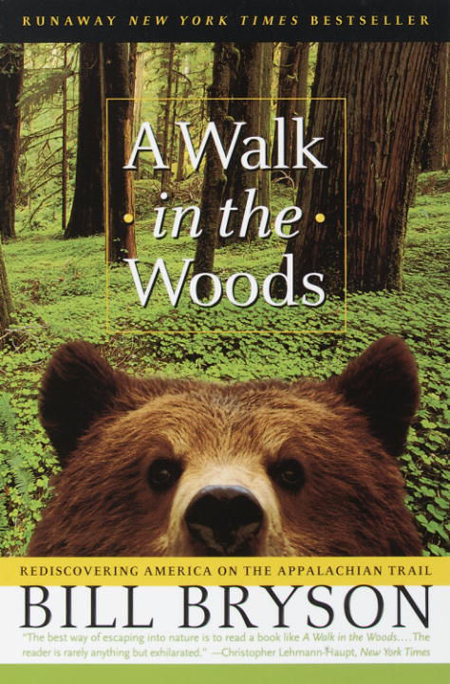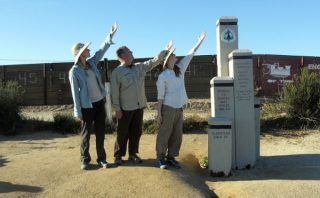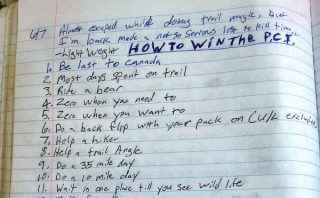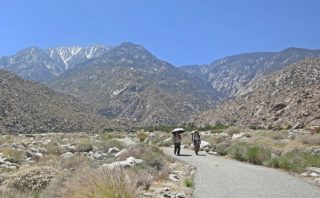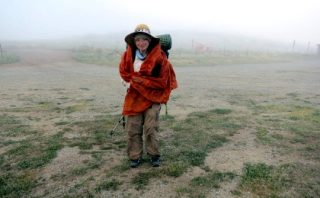In A Walk in the Woods, Bill Bryson writes about his experiences on the Appalachian Trail. I read this book during the first few weeks of my time on the Pacific Crest Trail. I read it mostly because Natalie gave it to me. A free book is a free book. After reading it, I put the book in a hiker box because books are heavy and every ounce matters. I also thought maybe another hiker would like to read it.
Sometimes Bryson was spot on about what I was going through on the trail. Here are some of my favorite quotes.
An Informal Clump
… perhaps two dozen of us altogether in the same general neck of the woods, all heading north. Because everyone walks at different rates and rests at different times, three or four times a day you bump into some or all of your fellow hikers, especially on mountaintops with panoramic views or beside streams with good water … In consequence you get to know your fellow hikers at least a little … You become part of an informal clump, a loose and sympathetic affiliation of people from different age groups and walks of life but all experiencing the same weather, same discomforts, same landscapes, same eccentric impulse to hike … (p. 71)
Just What You Do
Distance changes utterly when you take the world on foot. A mile becomes a long way, two miles literally considerable, ten miles whopping, fifty miles at the very limits of conception. The world, you realize, is enormous in a way that only you and a small community of fellow hikers know. Planetary scale is your little secret.
Life takes on a neat simplicity, too. Time ceases to have any meaning. When it is dark, you go to bed, and when it is light again you get up, and everything in between is just in between. It’s quite wonderful, really.
You have no engagements, commitments, obligations, or duties; no special ambitions and only the smallest, least complicated of wants; you exist in a tranquil tedium, serenely beyond the reach of exasperation … All that is required of you is a willingness to trudge.
There is no point in hurrying because you are not actually going anywhere. However far or long you plod, you are always in the same place: in the woods. It’s where you were yesterday, where you will be tomorrow. The woods is one boundless singularity. Every bend in the path presents a prospect indistinguishable from every other, every glimpse into the trees the same tangled mass. For all you know, your route could describe a very large, pointless circle. In a way, it would hardly matter.
At times, you become almost certain that you slabbed this hillside three days ago, crossed this stream yesterday, clambered over this fallen tree at least twice today already. But most of the time you don’t think. No point. Instead you exist in a kind of mobile Zen mode, your brain like a balloon tethered with string, accompanying but not actually part of the body below. Walking for hours and miles becomes as automatic, as unremarkable, as breathing. At the end of the day you don’t think, “Hey, I did sixteen miles today,” any more than you think, “Hey, I took eight thousand breaths today.” It’s just what you do. (p. 100-101)
Low-Level Ecstasy
If there is one thing [a long trail] teaches, it is low-level ecstasy – something we could all do with more of in our lives.
So I was happy. We were doing fifteen or sixteen miles a day, nothing like the twenty-five miles we had been promised we would do, but still a perfectly respectable distance by our lights. I felt springy and fit and for the first time in years had a stomach that didn’t look like a ball bag. I was still weary and stiff at the end of the day – that never stopped – but I had reached the point where aches and blisters were so central a feature of my existence that I ceased to notice them. (p. 179)
Gentle Descent into Squalor
Each time you leave the cossetted and hygienic world of towns and take yourself into the hills, you go through a series of staged transformations – a kind of gentle descent into squalor – and each time it is as if you have never done it before. At the end of the first day, you feel mildly, self-consciously, grubby; by the second day, disgustingly so; by the third, you are beyond caring; by the fourth, you have forgotten what it is like not to be like this. (p. 179)
Hunger
Hunger, too, follows a defined pattern. On the first night you’re starving for your noodles; on the second night you’re starving but wish it wasn’t noodles; on the third you don’t want the noodles but know you had better eat something; by the fourth you have no appetite at all but just eat because that is what you do at this time of the day. (p. 180)

